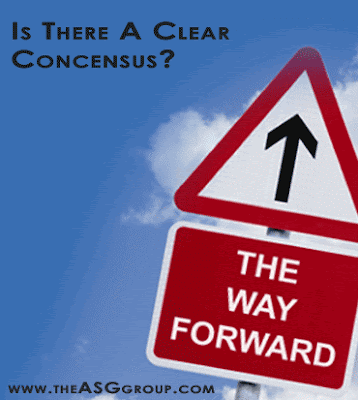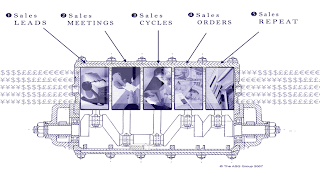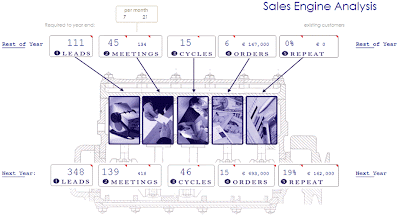Most sales managers we know have a clear view of the sales priorities, opportunities and challenges facing their organizations. That is great!
However, this clarity is often not present among other members of the sales, or management team. This lack of a clear consensus makes it more difficult for the sales manager to effectively translate strategies and priorities into action.

Maximizing sales success requires that the sales team must work in unison, following a clear and consistent strategy.
This strategy must integrate sales and marketing, while also ensuring organization wide and cross functional support.
Does Everybody Share the Sales Manager's Priorities?
In many organisations the clarity, consensus and buy-in regarding sales and marketing falls short of what is required.
That is because managers don't get to spend enough time ensuring that others share their assessment of sales and marketing performance and priorities.
That can make it difficult to get others to sign up to, and share responsibility for the required; strategies, resources and actions.
The Sales Managers Has to Sell His Priorities.
The first thing that the sales manager has to sell is his priorities, strategies and structures - together with improvements and innovations - for sales and marketing.
That is to sell them to the members of the sales and marketing team, as well as to other managers and their departments. Yet, this often gets overlooked. That means:
· The sales effort may not get the resources and the support that it needs.
· Responsibility for sales is not spread widely enough, with sales seen as the job of the sales manager, or sales person, as opposed to purpose of the business and an area to which all members of the team must contribute.
Issues that Require A Consensus.
Managers need to make a greater effort to ensure that there is a full appreciation and understanding of:
· The way forward
· Key sales opportunities and challenges
· What is and is not working
· The various roles and responsibilities
· New improvements, initiatives and innovations
· The key priorities and strategies
· Quantifiables and metrics to be used in tracking performance, etc.
How To Fast Track A Consensus.
How can managers fast track the process of getting people to buy-in to and sign-up for what needs to be done? In particular, how to side-step personalities and politics?
Well, the answer is to apply some of the process re engineering type principles common in many other areas of business. That means looking beyond the people to issues of processes, activities, efficiency and so on.
In particular, an effective way is for managers to get their team and their management counterparts to look at sales and marketing as the revenue generating engine of the business.
By framing the process around a concept with which everybody is familiar, one that is intuitive and logical – that is the engine - and looking under the hood' (or bonnet if you drive on the right hand side of the road) managers can get wider involvement, freer discussion and
fresher ideas.
Time to Lift the Hood on Sales.
Engines are an efficient means of achieving a desired result, that generally involves transforming one thing to another. In the case of a vehicle, it ignites a mixture of air and gas to move a piston and rotate a crank shaft and generate the power required to move.
The sales engine is the means by which your business generates revenue from both new and existing customers. It takes in leads at one end and converts them through stages (that is sales meetings and sales cycles) into orders and ultimately repeat orders. That is providing the power to accelerate sales and move your business forward.

Typically, for the complex sale, the sales engine has 5 cylinders, that is key stages of processes in the sales cycle, (the first 4 cylinders) and growing revenue from existing customers (the final cylinder).
Advantages of the Sales Engine View.
The advantages of looking at sales and marketing as an engine are as follows:
• It is a simple, intuitive and visible, plus it is light on terminology and therefore is accessible to all the team (including those outside sales). That makes it an effective tool for coaching, planning and facilitation.
• It looks beyond the people and personalities involved to depersonalize sales and marketing and thereby facilitates an objective view.
• It encourages looking at sales as an organisational capability, rather than just an individual, or team. Sales people will come and go, but the capability must remain with the company.
• It adopts a high level view that integrates all aspects of sales and marketing into a central framework that can serve to rally all managers and their departments around the sales effort.
• It sees all aspects of sales and marketing as being interconnected and interrelated, for example if the leads cylinder is broken this will have an impact on all other aspects of the engine. An engine is the perfect example of multiple components working together to deliver a result - something that the video below, showing an internal combustion engine, demonstrates well.
• It brings systems thinking to bear on sales and marketing, including the concepts of business process re engineering and continuous improvement. Moreover, it encourages looking at sales in terms of a science, rather than a black art, or set of ad hoc, or sporadic activities.
 • It is compatible with, and complementary to existing sales methodologies and processes that may exist within the sales team. It is just another way of looking at sales and marketing and getting a broader consensus.
• It is compatible with, and complementary to existing sales methodologies and processes that may exist within the sales team. It is just another way of looking at sales and marketing and getting a broader consensus.
• It employs terms, such as LEADS, MEETINGS, CYCLES AND ORDERS that are easy to apply. That is because they involve less subjectivity and are activity based. That means they can be tracked using most CRM, or sales reporting methods.
How is your engine performing?
So, if sales and marketing are viewed as the engine of the business, here are some good questions to ask:
• Is the sales engine running smoothly and purring nicely? Or is it labouring, chucking, or back firing?

• Is the sales engine firing on all cylinders? Or are some cylinders misfiring?
• Are there opportunities to fine tune, or even turbo charge any of the cylinders?
• Would a change of oil, spark plugs, or filters help?
• How powerful is the engine? Is it up to the job? Will it get us to where we want to be?
• How efficient is the engine? Is it giving delivering high MPG? Is there waste in any areas?
• How do we know if it performing at its best? Are the metrics clear? Is there a management dashboard? Are there tell tale signs if there is a problem?
• Who is responsible for engine maintenance / optimisation?
• When is the last time the sales engine was serviced, or fine tuned?
• How will the engine need to change to meet the companies growth ambitions / market conditions?
• If we were starting from scratch and building the engine again, would it be different?
Putting Metrics in Place.
When we help managers apply the concept of the sales engine to their business, we start with the metrics and work from there.
In the example below, for a start-up engineering business, the sales engine is used to determine the level of sales activity required to year end (above the engine) and for the next financial year (below the engine).
In this instance the manager can see that 111 leads and 45 sales meetings (companies as opposed to individuals met) are required in order to meet target based on anticipated conversion rates.
The performance of the sales engine can be improved by:

- Increasing the numbers for each cylinder (e.g. increasing leads generated from 111 to 120), or more importantly by;
- Improving the conversion ratio between the cylinders (e.g. increasing the conversion rate from sales meeting to sales cycle from 1 in 3 as shown above for the rest of the year, to 1 in 2).
Small Improvements Can Have A Major Impact.
The most important principle of the sales engine is that a number of small improvements made in a number of areas across the sales cycle can have a significant overall impact on overall win rates and sales success. For example, a 3% improvement at each stage of the sales cycle, or cylinder of the sales engine, can increase sales performance by up to 33%.
No two organisations, sales teams, or individuals have the same requirements, or the same levels of capability, or performance with respect of any or all of the cylinders. That means each
organisation, sales team or even each sales person's engine is different, and arriving a shared view of the engine across a sales team results in new insights into the way the organisation sells, and more importantly how this can be optimised.
In conclusion, when it comes to sales and marketing, it can be very helpful to lift the hood and get a consensus as to what is and should be happening underneath.
 Maximizing sales success requires that the sales team must work in unison, following a clear and consistent strategy.
Maximizing sales success requires that the sales team must work in unison, following a clear and consistent strategy. 

 • It is compatible with, and complementary to existing sales methodologies and processes that may exist within the sales team. It is just another way of looking at sales and marketing and getting a broader consensus.
• It is compatible with, and complementary to existing sales methodologies and processes that may exist within the sales team. It is just another way of looking at sales and marketing and getting a broader consensus.






No comments:
Post a Comment